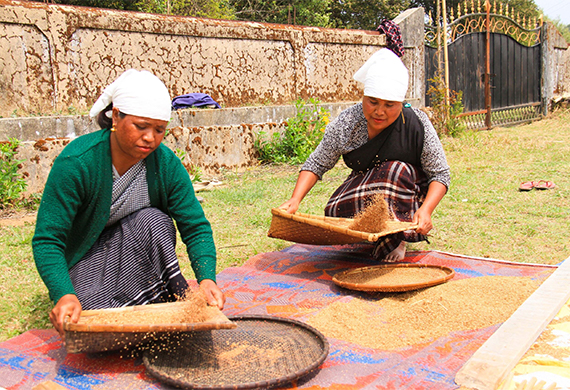
Women Farmers from Northeast India Powering Millet Revival for Sustainable Nutrition
By: WE Staff
Nestled in the enchanting landscapes of Northeast India, a captivating movement is currently underway to revive the cultivation and consumption of millets. These indigenous food items have held a significant place in the agricultural practices and dietary traditions of this region for centuries. Millets, known for their versatility in culinary applications and traditional brewing techniques, have recently garnered attention for their numerous health benefits and positive impact on local economies. In a concerted effort to raise awareness about the untapped potential of millets, a captivating millet recipe contest unfolded in the idyllic Gyalshing district of Sikkim.
This event served as a platform to showcase the culinary prowess of local farm women and members of self-help groups (SHGs), all while underscoring the vital role that millets play in enhancing nutrition, ensuring food security, and promoting sustainable agricultural practices. The festival's overarching theme, "Harnessing the untapped potential of Millet for food security, nutrition, and sustainable agriculture," echoed throughout the event, inspiring participants and attendees alike.
Women Farmers Driving the Millet Revival Movement
At the heart of the millet revival movement in Northeast India are the women farmers who have played a pivotal role in its success. These women, equipped with generations of traditional knowledge and skills, have become catalysts for change. From seed selection to cultivation, processing, and marketing, women farmers are actively engaged in every stage of the millet production cycle.
Their contributions are not only vital for the sustainability of millet cultivation but also the preservation of traditional farming practices, biodiversity, and cultural food systems. By actively participating in the revival of millets, these women are asserting their agency, breaking gender barriers, and empowering themselves as key stakeholders in the region's agricultural landscape.
The Significance of Millets in Northeast India
Millets have been an intrinsic part of the agricultural landscape and dietary culture in Northeast India for centuries. Finger millet, foxtail millet, buckwheat, and pearl millet are just a few of the diverse millet varieties that have nourished the communities in this region.
Beyond their nutritional benefits, millets have also proven to be climate-compliant and community-bonding crops, showcasing their resilience against the impacts of climate change. The cultivation of millets helps mitigate the challenges faced by the Northeast region, such as natural disasters and land degradation while providing sustainable livelihood opportunities for smallholder farmers.
By embracing millets, communities in Northeast India can not only ensure food security but also preserve their cultural heritage, promote biodiversity conservation, and strengthen the region's agricultural identity.
Empowering Communities through People-Led Development
The Northeast region of India, known for its unique traditional farming practices and rich biodiversity, faces a myriad of challenges such as natural disasters, land degradation, low productivity, and poor market linkages. In response to these challenges, Caritas India's Facilitating Agricultural Regeneration Measures (FARM) program has emerged as a transformative force.
FARM follows a people-led development approach, placing the power in the hands of local communities and involving smallholder farmers in decision-making and collective action. Through this program, millet cultivation has been successfully promoted, market linkages have been established, and support for processing and value addition has been provided. By empowering communities and enhancing their resilience, FARM not only addresses the immediate concerns of food security but also contributes to the long-term sustainability of the region's agricultural systems.
Collaborative Efforts and Knowledge Exchange
The 14th Biodiversity Festival hosted by the North East Network (NEN) served as a vibrant platform for diverse stakeholders invested in the millet revival movement. Farmers, NGOs, government departments, and research institutions came together to exchange knowledge, experiences, and ideas.
The festival facilitated learning among custodian farmers, enabling the sharing of traditional ecological knowledge and innovative farming practices. Participants discussed the importance of policy support for millet-based agriculture and the recognition of women's invaluable contributions. The event also provided an opportunity for farmers to showcase their millet produce, fostering market linkages and reinforcing the economic benefits of millets.
Promoting Millets for Food Sovereignty and Sustainable Livelihoods
The millet recipe contest held in the Gyalshing district was a standout feature of the festival, as it aimed to raise awareness about the health and economic benefits of millets. In addition to the contest, the festival showcased various elements, including biodiversity exhibitions, a farmers' market, crafts, millet food stalls, seed exhibitions, cultural performances, and the launch of a book on seeds and food sovereignty. These initiatives celebrated traditional farming practices and emphasized the importance of food sovereignty in the Eastern Himalayan region.
As Northeast India faces challenges such as climate change and land degradation, millets offer a climate-resilient alternative that contributes to food security, biodiversity conservation, and sustainable livelihoods. By embracing millets and empowering local communities, we can build a more resilient and sustainable future for the region and beyond.
In conclusion, the revival of millets in Northeast India symbolizes the power of women farmers and community-led efforts in revitalizing traditional agricultural practices. By recognizing the importance of millets for sustainable agriculture and food security, and actively involving women in the process, the region is paving the way for a more resilient and sustainable future. Collaborative initiatives, knowledge exchange, and policy support have further strengthened the millet revival movement. The efforts in Northeast India are not limited to this region alone, as similar initiatives across India are promoting millet and involving women in their cultivation and consumption.


.jpg)



